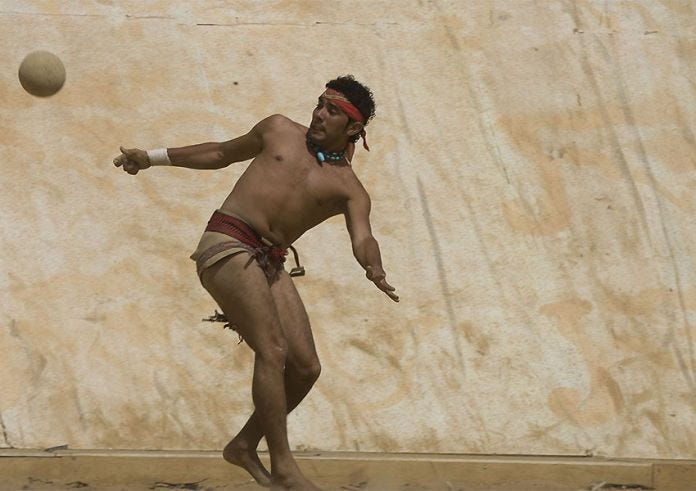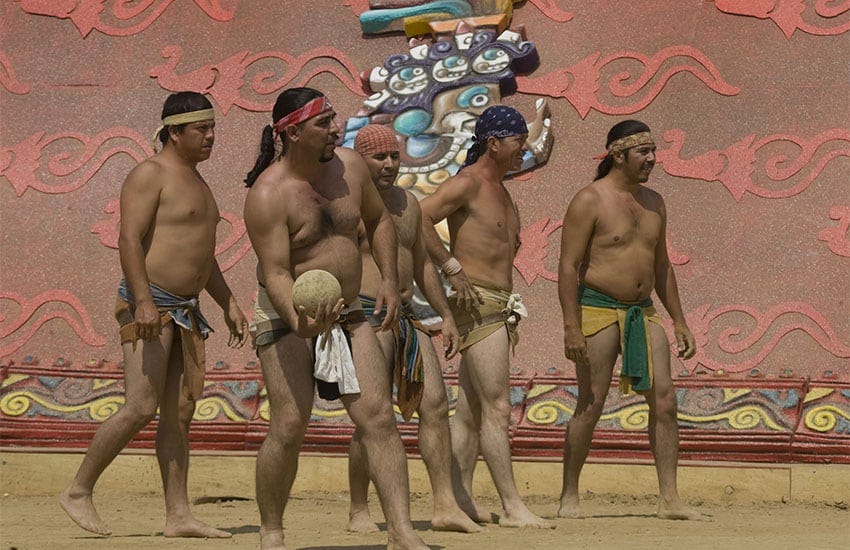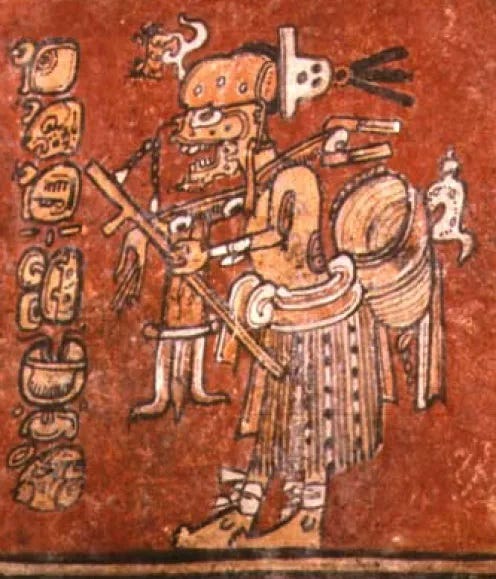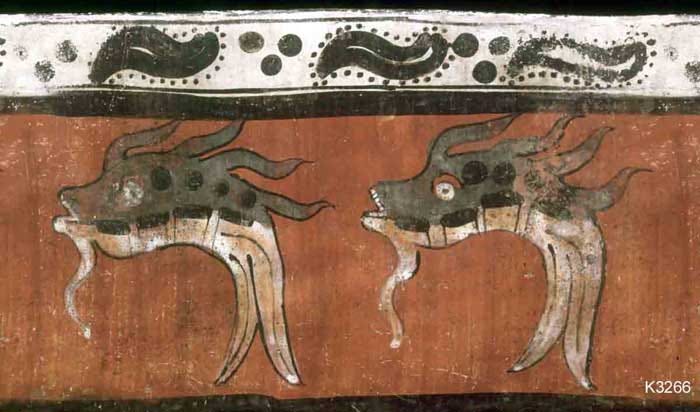
In 1968, on the first day of the Olympic Games held in Mexico City. Millions of spectators from around the world watched the ancient game of “Pok-ta-pok”, or Ulama in Nahuatl, or simply “the ballgame”.

The players are spectacular to watch. The game requires skill, endurance and athleticism. Players must leap into the air with great strength, yet with the grace of a ballet dancer as they twist their bodies to hit the ball with their hip.
This is the Mesoamerican “ballgame”. Pok-ta-pok to the Maya, ullamaliztli to the Aztecs, Ulama to modern players trying to revive the game.
This is the oldest known organized game in the history of sports.
It was played for over 3,500 years.
Our understanding of the ballgame comes from three sources: firsthand accounts — both from Spanish and indigenous accounts of Aztec ballgames, the account of the ballgame of the Hero Twins with the Lords of Death in the Popul Vuh, and what archeology, both in excavated ballcourts and artifacts like the vase above, reveals.
Let’s look at what each of these sources can tell us.
Firsthand accounts:
When they landed in the New World, the Spanish had never seen a ballgame like this, let alone a rubber ball. The Europeans were so intrigued, they sent a team of indigenous players to Spain to show the game to Charles V who, it’s recorded, was delighted at the spectacle.
That is all we know about these men who were shipped to Spain like exotic animals to perform for their new overlord. We don’t know their names. We don’t know if they volunteered to make the journey or if they were slaves.
Perhaps they thought that after they played the game for their captors they would be ritually sacrificed. A fate that was not uncommon for war captives in Aztec culture.
Did they return to Mexico, or did they die in Spain?

We know nothing, other than that a team of players performed the ballgame for Charles V and that he, “was delighted”. Nobody thought to write down details of the game or the rules. Perhaps they thought there would be plenty of time for that. After all, the reports said that the new lands had populations in the millions and dozens of great cities.
But then the plagues started winnowing the indigenous populations and within a few decades over 90% of them were dead. Few players of the ballgame were left after that.
Still, the ballgame might have been revived. But, as the Spanish began tightening their grip on Mesoamerica, they decided to stamp out the game. Forbidding anyone from playing it because of its associations with human sacrifice and “idolatrous” religious practices.
Which was the end of a 3,500-year-old tradition dating back to 2,000 BCE.
In the 1570’s the Dominican friar Diego Duran interviewed indigenous elders and Spaniards who had seen the game played. Ironically, although he never saw the game actually played, his account of the Aztec version of the ballgame is the only “firsthand” information we have about it.
According to Duran, Spaniards who saw the Aztec games in the early 1500s reported that two teams of two to five players had to keep the ball in the air without using their hands or feet. They hit the ball with their upper arms, thighs, or hips.
The rubber balls they used were of varying weight and size, from the size of a softball to a soccer ball. These solid rubber balls were heavy. Up to eight or nine pounds, and could cause serious injury or even death according to Duran’s witnesses.
The object of the game was to keep the ball in motion and score points against the other team if they let the ball touch the ground, or escape from the court on their side. The sloping walls on each side of the central trench could apparently be used for both bouncing the ball or “rolling” the ball along them.

In much the way that Cricket can be incomprehensible if you don’t grow up playing it. The intricacies of the ballgame seem to have been lost on the Spanish observers. They were unable to provide Duran with rules for the game, only accounts of what they had observed.
Games seemed to be won mostly by points and could go on for hours. However, Durán wrote that sometimes the ball would go through a hoop, located at the alley’s midpoint.
“If that happened, the whole game would stop and the person who put the ball through the hoop would be hailed a victor,”
However, Durán doesn’t say that was the point of the game. He states that it happened rarely and that it was truly exceptional.
Duran wrote that sometimes royalty would play the game. But regardless of whether royalty or regular athletes were in the playing alley, the games were heavily attended. With crowds of spectators and a carnival atmosphere. People gambled and bet on the outcomes with some people losing large sums, even their clothes.
From Duran’s accounts the game seems to have served many social purposes.
For the Aztecs, it was a sandlot sport for youth that every male child would grow up playing. A shared cultural experience.
For adults it was a public game attended by spectators. With professional athletes in a dangerous gladiatorial environment, where serious injuries or even death might happen.
There were religious aspects to the game because the Gods played it and it served as a metaphor for the unending cycle of day and night. Several times a year there might be “passion play” reenactments of the ballgame of the Gods.
Lastly, there was a bloody spectacle aspect to the game. Criminals and war captives might be ritually executed at a major ballgame. Perhaps after being allowed to play a game to determine if they would live or die.
If Duran’s accounts are to be believed, the Aztec ballcourts served the same social purpose as the Roman Colosseum.
At the height of the Aztec empire, the annual tribute demanded by Tenochtitlan in rubber balls totaled 16,000. They came from the lowland coastal province of Tochtepec, the ancient Olmec land.
In one of the most richly illustrated tribute pages of the famous Codex Mendoza we find recorded the glyphs for 2 x 8,000 (incense bags) = 16,000 rubber balls.
This was a huge increase on the 2,000 balls demanded annually in tribute by the original conqueror of the region (Nezahualcoyotl of Texcoco) just a few decades earlier. According to one researcher (see The Ball by John Fox) it would have taken about 1,300 acres of land and over 400 full-time rubber tappers to meet that sort of level of annual rubber ball tax.
Unfortunately, that’s all the “firsthand” information we have. Some of the Spanish saw the ballgame being played and decades later recounted what they had seen and remembered. Enough to give us a basic idea of how the game was played in the twilight days of the Mesoamerican culture.
Remember that the ballgame played by the “Classic Maya” was about 750 years earlier than the Spanish accounts.
Because the appearance of the court, the balls, and the basic play of the game doesn’t seem to have changed much in those years. It seems like a reasonable assumption that much of what Duran reports probably represented cultural continuity. However, that is only an assumption, not a fact.
The game seems to have always had religious significance throughout its 3500 year lifespan. However, as you would expect, that significance and its reason changed from society to society.
For the Maya, the religious significance of the ballgame seems to be based on the ballgames played by the Hero Twins Hunahpu and Xbalanque against the Lords of Death in Xibalba as recounted in the Popul Vuh.
The Popul Vuh and the Ballgame.
Even if your interest in the Maya is only casual you will hear about the Popul Vuh, or “Popul Wuj” in the Ki’che language. It’s presented by tour guides and the uninformed as the “Maya Bible” and the main thing they take away from it is that there’s a ballgame in it. A ballgame where the losers are killed.
That is the basis for the widespread belief that, at least once a year, the Maya would have a ritual ballgame and sacrifice the losers in a recreation of that primal ballgame. That the Maya practiced human sacrifice as the Spanish claimed.
Not considering anything about what the Popul Vuh represents, or the complex story of its interpretation in the 20th century, here’s the basic story of the ballcourt of the Lords of Death and the victory over them by the Hero Twins, Hunahpu and Xbalanque in Xibalba.
To understand the story, you need to understand about “Xibalba”.
In the beginning, after reality was created out of chaos by the placement of the three hearth stones that sit at the center of everything, the world was covered by water. There were no humans in this watery world but there were all sorts of supernatural beings who interacted with each other.
One of them, known to us as “The Young Maize God”, separated the water from the land and made the sky by erecting the “World Tree” to act as the pillar of the world.
In the roots of the tree, below the ground, was “Xibalba”. The Underworld, land of the Lords of Death. In the “mid-world” of the great tree’s trunk was the world of humans. In its upper branches, held far above our world, was the heavens. A place where your soul might go at last after walking the “white road” (the Milky Way) to reach it.
Xibalba is the underworld.
It is described in the Popul Vuh as a court below the surface of the world associated with death and ruled over by twelve gods known as the Lords of Xibalba. The leaders of these twelve gods were the twins Hun-Ca’me (“One Death”) and Vu’cub-Ca’me (“Seven Death”). Twins, symbolizing duality, are a central feature of the Maya, Mesoamerican, and Amerindian cultures.
The remaining ten Lords are often referred to as demons and are given commission and domain over various forms of human suffering: to cause sickness, starvation, fear, destitution, pain, and ultimately death.
These Lords all work in pairs:
Xiquiripat (“Flying Scab”) and Cuchumaquic (“Gathered Blood”), who sicken people’s blood.
Ahalpuh (“Pus Demon”) and Ahalgana (“Jaundice Demon”), who cause people’s bodies to swell up.
Chamiabac (“Bone Staff”) and Chamiaholom (“Skull Staff”), who turn dead bodies into skeletons.
Ahalmez (“Sweepings Demon”) and Ahaltocob (“Stabbing Demon”), who hide in the unswept areas of people’s houses and stab them to death.
Xic (“Wing”) and Patan (“Packstrap”), who cause people to die coughing up blood while out walking on a road.
The remaining residents of Xibalba are thought to have fallen under the dominion of one of these Lords, going about the face of the Earth to carry out their listed duties.
The story of the great ballgame starts with the father and uncle of the Hero Twins, the supernatural twins Hun Hunahpú and Vucub Hunahpú. This pair were playing the ballgame in the mid-world where they lived and annoyed the gods of the underworld with their noisy playing. To get rid of them the two brothers were tricked into descending into Xibalba where they were challenged to a ball game.
Losing the game, Hun Hunahpú had his head cut off and hung in a tree.
This was a common cultural practice for Maya kings to do to their defeated enemies. There are depictions of kings sitting on thrones with a “royal tree” behind them, filled with the heads of their enemies. The Maya even had a god of decapitation who was invoked during ritual decapitation ceremonies. So, this fits with Maya cultural practice.
Now, because Hun Hunahpu is a supernatural being he does not die. His head hangs in the tree. Until one day princess Xquic, who is the daughter of Hun Ca’me, comes by and is seduced by the talking head.
He impregnates her with his spit (bodily fluids like blood, sweat, semen, and saliva had a lot of manna in the Maya magico-theological worldview) and she births the hero twins. Who, she takes to the mid-world to be raised by their grandmother.
The hero twins have all sorts of adventures, do all sorts of heroic things, meet all sorts of interesting and helpful gods and monsters, and eventually go back to Xibalba for a rematch with the nasty Lords who killed their father. If you are thinking that this sounds like Joseph Campbell’s “The Hero’s Journey” good for you, because it does.
Campbell’s point was that all hero stories from the very beginning, right up to the Hollywood movies of today, are essentially the same story. People love that story, and we tell it to ourselves over and over again, including the Ancient Maya.
Xibalban ballgames
It starts with Hunahpu and Xbalanque playing ball in the mid-world on the same ballcourt that their father and uncle had played on long before them. When the twins began to play ball in the court, once again the Lords of Xibalba are disturbed by the racket and send a summons to the boys to come to Xibalba and play in their court.
Fearing they would suffer the same fate as their father and uncle, their grandmother relayed the message only indirectly. Telling it to a louse which was hidden in a toad’s mouth, which was in turn hidden in the belly of a snake in a falcon. Nevertheless, the boys did receive the message. And much to their grandmother’s dismay, set off to Xibalba.
When their father had answered the summons, he and his brother had faced challenges along the way. Challenges which served to confuse and embarrass them before their arrival in Xibalba. However, the sons of Hun Hunahpu would not fall victim to the same tricks.
They sent a mosquito ahead of them to bite at the Lords and uncover which were real and which were statues, as well as uncovering their identities. When they arrived at Xibalba, they were easily able to identify which were the real Lords of Xibalba and address them by name.
They also turned down the Lords’ invitation to sit on a bench for visitors, correctly identifying the bench as a red-hot cooking stone. Frustrated by the twins’ ability to see through their traps, the Lords send the boys away to the Dark House, the first of several deadly tests devised by the Xibalbans.
Their father Hun Hunahpu and his brother had suffered embarrassing defeats in each of the tests, but again Hunahpu and Xbalanque demonstrate their prowess by outwitting the Xibalbans on the first of the tests. They survive the night in the pitch-black house without using up their torch.
Dismayed, the Xibalbans bypassed the remaining tests and invited the boys directly to the game. The twins knew that the Xibalbans used a special flying ball that had a blade in it with which to kill them.
Instead of falling for the trick, Hunahpu stopped the ball with a paddle and revealed the blades. Complaining that they had been summoned only to be killed, Hunahpu and Xbalanque threatened to leave the game.
As a compromise, the Lords of Xibalba allowed the boys to use their own rubber ball, and a long and proper game ensued. In the end, the twins allowed the Xibalbans to win the game, but this was again, a part of their plan.
They were sent to Razor House, the second deadly test of Xibalba, filled with knives that moved of their own accord. The twins, however, spoke to the knives and convinced them to stop, thereby surviving the test.
They also sent leaf-cutter ants to retrieve flower petals from the gardens of Xibalba, as a prize for the Lords for winning the game. The Lords had intentionally chosen a prize they thought it was impossible for the twins to procure, but the guards did not take notice of the ants and the twins survived another day.
They played a rematch with the Xibalbans and lost by intent again. This time they were sent to Cold House, the next test. This test they defeated, as well. Each time, Hunahpu and Xbalanque lost the ballgame so that they might be sent to the remaining tests: Jaguar House, Fire House, and Bat House to defeat the tests of the Xibalbans.
The Lords of Xibalba were dismayed by the twin’s successes until the twins were placed in Bat House. Though they hid inside their blowguns from the deadly razor bats, Hunahpu peeked out to see if daylight had come, and was decapitated by the bat god Camazotz.
The Xibalbans were overjoyed that Hunahpu had been defeated and demanded the next ball game be played at once. Xbalanque managed to stall them and summoned the beasts of the field, who fashioned a replacement head for Hunahpu.
Hunahpu’s original head was to be used as the ball for the next day’s game, but the animals were able to surreptitiously substitute a gourd for the head. After retrieving Hunahpu’s real head, he was restored, and the twins defeated the Xibalbans.
Embarrassed by their defeat, the Xibalbans still sought to destroy the twins.
They had a great oven constructed and once again summoned the boys. Intending to trick them into the oven and to their deaths.
The twins realized, that the Lords had intended this ruse to be the end of them. But nevertheless they allowed themselves to be burned in the oven and ground into dust and bones.
The Xibalbans were elated at the apparent demise of the twins and cast their remnants into a river. This was, however, a part of the plan devised by the boys.
From the Popol Vuh translated by Dennis Tedlock.
"This is a good death for them, and it would also be good to grind their bones on a stone, just as corn Is refined to flour, and refine them separately, and then:
Spill them Into the river, sprinkle them on the water’s way among the mountains, small and great, you will say, and then you will have carried out the instructions we’ve named for you," said Hunahpú and Xbalanqué. When they gave these instructions they already knew they would die.
...After that they summoned Xulu and Pacan, who kept their word: the bones went just where the boys had wanted them. Once the Xibalbans had done the divination, the bones were ground and spilled In the river, but they didn’t go far ... they just sank to the bottom of the water."
...AND ON THE FIFTH DAY THEY REAPPEARED. They were seen in the water by the people. The two of them looked like channel catfish when their faces were seen by Xibalba."
Not recognizing them, the boys were allowed to remain among the Xibalbans. Tales of their transformation from catfish spread, as well as tales of their dances and the way they entertained the people of Xibalba.
They performed several miracles, setting fire to homes and then bringing them back whole from the ashes. They sacrificed one another and then each rose from the dead.
When the Lords of Xibalba heard the tale, they summoned the pair to their court to entertain them. Demanding to see such miracles in action.
The boys answered the summons and volunteered to entertain the Lords at no cost. They claimed to be orphans and vagabonds, and the Lords were none the wiser.
They went through their gamut of miracles, slaying a dog and bringing it back from the dead. Causing the Lords’ house to burn around them while the inhabitants were unharmed. Then bringing the house back from the ashes.
In a climactic performance, Xbalanque cut Hunahpu apart and offered him as a sacrifice. Only to have the older brother rise, once again, from the dead.
Enthralled by the performance, One Death and Seven Death the highest lords of Xibalba, demanded that the miracle be performed upon them. This was the moment the twins had been working towards all along.
The twins obliged the Lords by killing and dismembering them but, as you might expect, did not bring them back from the dead. They were truly defeated at last.
The twins then shocked the inhabitants of Xibalba by revealing their identities as Hunahpu and Xbalanque. The sons of One Hunahpu whom they had slain years ago along with his brother Seven Hunahpu.
The Xibalbans despaired, confessed to the crimes of killing the elder brothers years ago, and begged for mercy.
The twins declared that as a punishment for their crimes, the realm of Xibalba was no longer to be a place of greatness. That the Xibalbans would no longer receive offerings from, or have power over, the people who walked on the Earth above. That they must stay in the Underworld forever.
The twins retrieved the buried remains of their father, Hun Hunahpu and reunited them with his head from the tree. Finished, the three departed Xibalba and climbed back up to the surface of the Earth.
They did not stop there, however, and continued climbing straight on up into the sky. One became the Sun, the other became the Moon.
As you can see, the story is much more complex than a simple ballgame of “Heroes versus Death Lords”.
There is a huge amount that could be unpacked from this story if it is deconstructed. However, this is the basic story of the ballgames of the Hero Twins and the Lords of Xibalba as recounted in the Popul Vuh.
The Popul Vuh has outsized importance to us in trying to understand the theology and culture of the ancient Maya, because it is our only source directly from the Maya themselves. We know that it has a high degree of validity because imagery that aligns with the stories can be found throughout the Maya cultural area.
Hero Twin imagery has been found in Maya preclassic sites that date back to 1,500 BCE and it has been found at Classic Maya sites everywhere. It’s painted on walls, on pots, and represented in sculpture.
So, even though the Popul Vuh was written around 1550, the stories recounted in it seem to match Maya religious mythology dating back to the earliest days of the Maya culture. Whatever its flaws, it is telling us some of the foundational cultural beliefs of the ancient Maya.
Having looked at the firsthand accounts and the Popul Vuh, what does the archeology tell us?
END PART ONE
-rc
033023
















